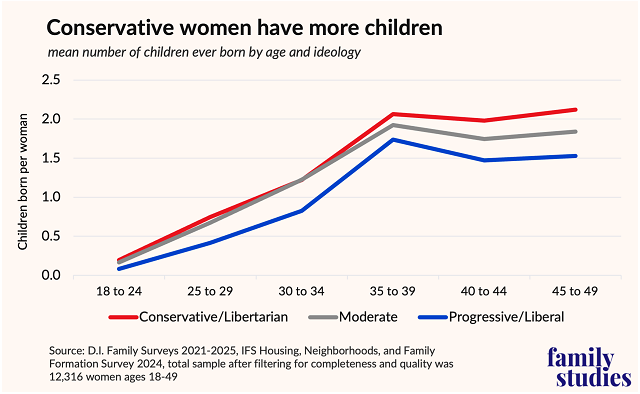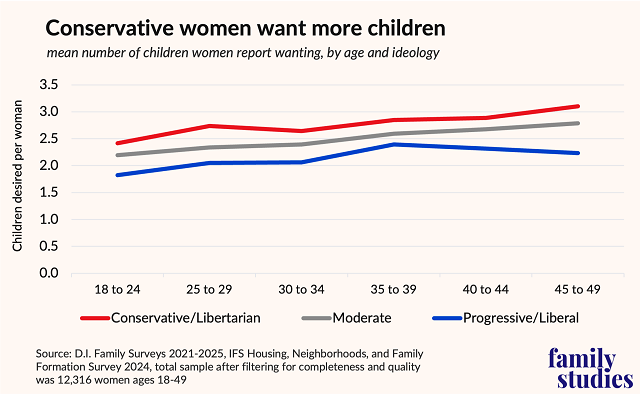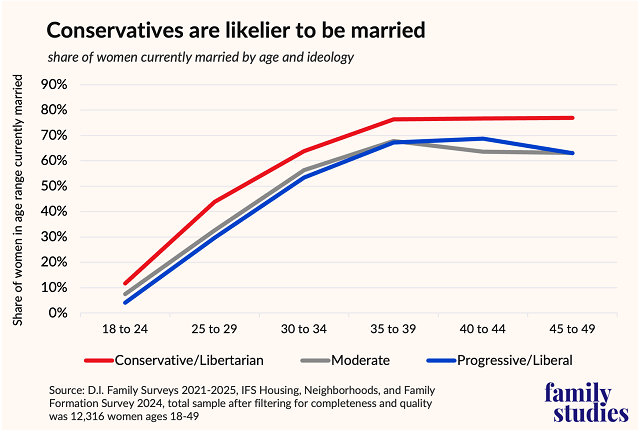Highlights
- Conservative women don’t just have more children than liberal women; conservative women want more children and they’re likelier to marry, and to marry young. Post This
- Married women have substantially more children than unmarried women, and conservative women are much more likely to be married at every age. Post This
- Differences between conservative and liberal women should not be overstated. Birthrates and marriage rates are lower for all groups. Yet the differences are large enough that the parties ultimately appeal to manifestly different constituencies. Post This
America’s partisan divide is manifest in attitudes toward family life and in actual family practice. Democrats increasingly seem to be the party of single women and the childless. Republicans, by contrast, are increasingly the party of those who value marriage and children. This partisan divide on family is growing around the world.
In the United States, counties that supported Donald Trump for president in 2024 had significantly higher birth rates than counties that supported Kamala Harris, as a previous IFS study showed. The higher Trump’s margin of victory, the higher the birth rate. The 20% of counties where Trump had the highest margin had a total birth rate (TFR) of 1.76 (above the national average of 1.63 in 2024). The higher Harris’s margin of victory, the lower the birth rate. The top 20% of counties that voted for Harris had a TFR of 1.37.
State-level data reveals a similar relationship between partisanship and fertility. Democratic states have much lower fertility rates than Republican states. But why do conservatives have more babies?
Using survey data that we collected for other recent projects from almost 13,000 women in 2021-2025, we looked at two key factors shaping the ideological fertility difference: marriage and desired family size.1 It turns out that conservative women don’t just have more children than liberal women; conservative women want more children than liberal women, and they’re likelier to marry, and to marry young enough to have more children. Thus, the ideological gap in birth rates represents two deeper, underlying gaps : an ideological difference in marriage, and an ideological gap in the desire for children.
The Democratic constituency is genuinely less family-oriented, while Republicans are more so—and this gap is growing over time.
Conservative Women Have More Babies
Conservative women born between 1975 and 1979—women who are finished having children—have a completed family size of 2.1, right at replacement. Moderate women in the same age group have 1.8 children, and liberal women just 1.5. Narrower gaps exist between conservatives born between 1985 and 1989, who have a completed fertility rate of 2.1, while moderates are at 1.9 and liberals 1.7. Conservative women born between 1995 and 1999 have, so far, only had 0.7 children, the same as moderates. Liberals in the same cohort average 0.4 so far.

The differences are also stark when only married women are surveyed. Conservative married women born between 1975 and 1979 have a completed TFR above 2, while the cohorts who are 10 years younger have family sizes even higher: around 2.25. Even moderate married women have TFR near replacement if they were born between 1975 and 1989. Progressive women between 45 and 49 years of age had only 1.58 children per married woman, a lower number than the liberal women who are between 35 and 44 years old. The late 1970s had substantially worse fertility conditions for all groups than the late 1980s. Married liberal women continue to trail conservative and moderate women in cohorts born after 1990.

Conservative Women Want More Children
Women of all ages, ideological dispositions, and marital statuses would prefer to have more children than they actually have. Conservative women, no matter their age, desire above replacement total fertility—from between 2.4 (those born between 2000 and 2004) and 3.1 (between 1975 and 1979) children. The gap between desired fertility among this oldest conservative cohort in the survey and actual fertility (2.1) is substantial. Moderate women want fewer children than conservatives. And liberal women want significantly fewer children than conservatives do and slightly fewer than moderates. The youngest cohort of liberal women is the first in these surveys to desire below replacement family size: those born between 2000 and 2004 desire only 1.8 children per woman.

Marriage Plays a Big Role in Fertility
Married women have substantially more children than unmarried women, and conservative women are much more likely to be married at every age. Over three-quarters of conservative women born before 1985 are married. Only about two-thirds of liberal women born before 1985 are married. On marriage, moderates resemble liberals more than they do conservatives. Trends suggest that marriage rates among liberal women will be increasingly different from conservative women in the future.

Differences between conservative and liberal women should not be overstated. Birthrates are lower for all groups when compared to the state of fertility before 1975. Marriage rates for all groups are lower, too. Yet the differences are large enough that the parties ultimately appeal to manifestly different constituencies. The Democratic constituency is genuinely less family-oriented, while Republicans are more so—and this gap, if anything, is growing over time.
President Trump’s interest in extending child tax credits appeals to his voters much more than former president Joe Biden’s plan appealed to his base, though the “One Big Beautiful Bill” left a lot of important work on that front unfinished. While Trump’s family policy has been front-and-center of his message to voters, Biden’s Child Tax Credit expansions, though actually larger than the current president’s, were couched entirely in terms of economic safety and COVID relief—and never articulated the recognition of the intrinsic value of childbearing and childrearing to society. Moreover, both parties have an interest in appealing to different female constituencies in the future. For example, former Vice President Harris received 59% of the vote among single women, yet only 48% among married women. As we have shown here, our two major political parties are increasingly divided on family ecosystems.
Scott Yenor is Senior Director of State Coalitions at the Claremont Institute’s Center for the American Way of Life and a professor of political science at Boise State University. Lyman Stone is Senior Fellow and Director of the Pronatalism Initiative at the Institute for Family Studies.
1. 9,055 women ages 18-44 sampled in the Demographic Intelligence Family Survey 2021-2025 had complete data for this analysis, as well as 3,682 women sampled in the 2024 IFS Housing, Neighborhoods, and Family Formation Survey.















